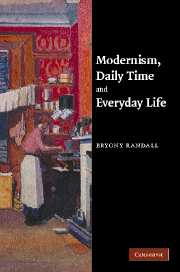Book contents
- Frontmatter
- Contents
- Acknowledgements
- List of abbreviations
- Introduction: dailiness
- Chapter 1 The contemporary context: Henri Bergson and William James
- Chapter 2 Dailiness in Dorothy Richardson's Pilgrimage
- Chapter 3 Re-creation, work and the everyday in Gertrude Stein
- Chapter 4 War-days: H.D., time and the First World War
- Chapter 5 Reading, writing and thinking: a Woolfian daily life
- Afterword
- Notes
- Bibliography
- Index
Chapter 4 - War-days: H.D., time and the First World War
Published online by Cambridge University Press: 22 September 2009
- Frontmatter
- Contents
- Acknowledgements
- List of abbreviations
- Introduction: dailiness
- Chapter 1 The contemporary context: Henri Bergson and William James
- Chapter 2 Dailiness in Dorothy Richardson's Pilgrimage
- Chapter 3 Re-creation, work and the everyday in Gertrude Stein
- Chapter 4 War-days: H.D., time and the First World War
- Chapter 5 Reading, writing and thinking: a Woolfian daily life
- Afterword
- Notes
- Bibliography
- Index
Summary
I have not painted the war […]. But I have no doubt that the war is in these paintings I have done.
INTRODUCTION: ‘THE WAR’, DAILINESS AND TRAUMA
H.D.'s autobiographical narratives Her, Asphodel, Bid Me To Live and Paint It Today form a palimpsest of texts covering the years from H.D.'s adolescence in Pennsylvania, through her establishment in London in the early years of the twentieth century, to the birth of her daughter in 1919. The dramatic changes which take place – both in the protagonist and in the world – through this period, can be gauged by examining the different responses to the day and dailiness in these texts, as an apparently stable temporal referent takes on a range of very different associations.
The narrative of H.D.'s early youth, Her, is characterised by a stifling sense of restriction, expressed through descriptions of the oppressive heat of the Pennsylvania summer, and of the limited and limiting social circle, the ‘Anglo-saccharine backwash’, of Pennsylvania society – associated with Bryn Mawr, the college at which H.D. (and hence her protagonist here, Hermione) was deeply unhappy. Hermione's attempt to explain and understand the disturbing currents in which she is caught up in this period of her life – her relationship with George Lowndes (the Ezra Pound figure), her engagement to him, and crucially her lesbian relationship with Fayne Rabb (Frances Gregg) – provides the strongest statement to be found in these texts of the day as, unexpectedly, aggressor.
- Type
- Chapter
- Information
- Modernism, Daily Time and Everyday Life , pp. 124 - 154Publisher: Cambridge University PressPrint publication year: 2007



